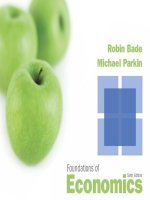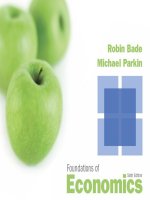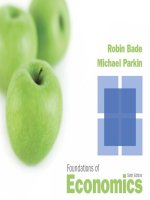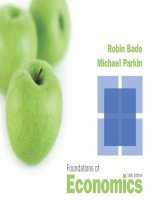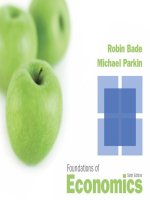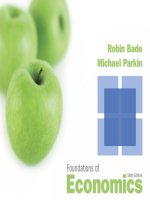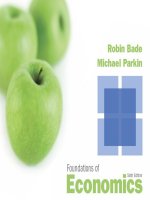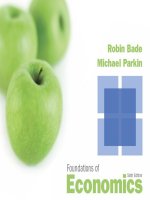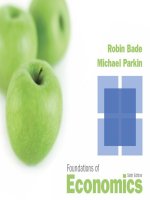Foundaions of economics 6th by robin bade ch02
Bạn đang xem bản rút gọn của tài liệu. Xem và tải ngay bản đầy đủ của tài liệu tại đây (1.22 MB, 53 trang )
Who makes the iPhone?
© 2013 Pearson
The U.S. and
Global Economies
2
CHAPTER CHECKLIST
When you have completed your
study of this chapter, you will be able to
1 Describe what, how, and for whom goods and services are
produced in the United States.
2 Describe what, how, and for whom goods and services are
produced in the global economy.
3 Use the circular flow model to provide a picture of how
households, firms, and governments interact in the U.S.
economy and how the U.S. and other economies interact in
the global economy.
© 2013 Pearson
2.1 WHAT, HOW, AND FOR WHOM?
What Do We Produce?
We divide the vast array of goods and services
produced into:
• Consumption goods and services
• Capital goods
• Government goods and services
• Export goods and services
© 2013 Pearson
2.1 WHAT, HOW, AND FOR WHOM?
Consumption goods and services are goods and
services that are bought by individuals and used to
provide personal enjoyment and contribute to a person’s
standard of living.
Examples are movies and laundromat services.
Capital goods are goods that are bought by
businesses to increase their productive resources.
Examples are cranes and trucks.
© 2013 Pearson
2.1 WHAT, HOW, AND FOR WHOM?
Government goods and services are goods and
services that are bought by governments.
Examples are missiles, bridges, and police protection.
Export goods and services are goods and services
produced in one country and sold in other countries.
Examples are airplanes produced by Boeing and
Citicorp banking services sold to China.
© 2013 Pearson
2.1 WHAT, HOW, AND FOR WHOM?
The figure shows the
relative magnitudes of
the goods and services
produced in the United
States in 2011:
Consumption 61%
Capital goods 11%
Export goods 11%
Government 17%
© 2013 Pearson
2.1 WHAT, HOW, AND FOR WHOM?
The figure shows the
largest six types of
services produced in the
United States in 2011 …
and the largest four
types of goods
produced.
© 2013 Pearson
2.1 WHAT, HOW, AND FOR WHOM?
How Do We Produce?
Factors of production are the productive resources
used to produce goods and services.
Factors of production are grouped into four categories:
• Land
• Labor
• Capital
• Entrepreneurship
© 2013 Pearson
2.1 WHAT, HOW, AND FOR WHOM?
Land
Land includes all the “gifts of nature” that we use to
produce goods and services.
Land includes all the things we call natural resources.
Land includes minerals, water, air, wild plants, animals,
birds, and fish as well as farmland and forests.
© 2013 Pearson
2.1 WHAT, HOW, AND FOR WHOM?
Labor
Labor is the work time and work effort that people
devote to producing goods and services.
The quality of labor depends on how skilled people are
—what economists call human capital.
Human capital is the knowledge and skill that people
obtain from education, on-the-job training, and work
experience.
© 2013 Pearson
2.1 WHAT, HOW, AND FOR WHOM?
Capital
Capital consists of tools, instruments, machines,
buildings, and other items that have been produced in
the past and that businesses now use to produce
goods and services.
Capital includes semifinished goods, office buildings,
and computers.
Capital does not include money, stocks, and bonds.
They are financial resources.
© 2013 Pearson
2.1 WHAT, HOW, AND FOR WHOM?
Entrepreneurship
Entrepreneurship is the human resource that
organizes labor, land, and capital.
Entrepreneurs come up with new ideas about what and
how to produce, make business decisions, and bear the
risks that arise from these decisions.
© 2013 Pearson
2.1 WHAT, HOW, AND FOR WHOM?
For Whom Do We Produce?
Factors of production are paid incomes:
Rent Income paid for the use of land.
Wages Income paid for the services of labor.
Interest Income paid for the use of capital.
Profit (or loss) Income earned by an entrepreneur for
running a business.
© 2013 Pearson
2.1 WHAT, HOW, AND FOR WHOM?
Functional distribution of income is the distribution
of income among the factors of production.
Personal distribution of income is the distribution of
income among households.
© 2013 Pearson
2.1 WHAT, HOW, AND FOR WHOM?
Figure 2.1(a) shows the
functional distribution of
income in 2010:
Wages 69%
Rent, interest, and profit 31%
© 2013 Pearson
2.1 WHAT, HOW, AND FOR WHOM?
Figure 2.1(b) shows the
personal distribution of
income in 2010:
The poorest 20% earned
only 3% of total income.
The richest 20% earned
51% of total income.
© 2013 Pearson
2.2 THE GLOBAL ECONOMY
The People
U.S. population: 312,774,632 ( December, 31, 2011)
World population: 7, 021,659,000
The U.S. clock ticks along showing a population
increase of one person every 12 seconds.
The world clock spins faster, adding 30 people in the
same 12 seconds.
© 2013 Pearson
2.2 THE GLOBAL ECONOMY
The Countries
Advanced Economies
The richest 29 countries (or areas).
Almost 1 billion people (15 percent of the world’s
population) live in advanced economies.
© 2013 Pearson
2.2 THE GLOBAL ECONOMY
Emerging Market and Developing Economies
Emerging market economies are the 28 countries of
Central and Eastern Europe and Asia.
Almost 500 million people live in these countries.
Developing economies are the 118 countries in Africa,
Asia, the Middle East, Europe, and Central and South
America that have not yet achieved high average
incomes for their people.
More than 5 billion people live in these countries.
© 2013 Pearson
2.2 THE GLOBAL ECONOMY
What in the
Global Economy?
In 2010, global
economy produced
about $70 trillion of
goods and services.
Figure 2.2 shows the
shares of global
production.
© 2013 Pearson
2.2 THE GLOBAL ECONOMY
Energy is produced from oil, coal, natural gas, waterfalls
and dams, nuclear reactors, windmills, and solar panels.
Each of these sources of power uses different
combinations of land (which includes natural
resources), labor, and capital.
Figure 2.3 shows some interesting facts about energy
use and production.
© 2013 Pearson
2.2 THE GLOBAL ECONOMY
About 80 percent of the
energy we use is in the
form of electricity.
The other 20 percent is for
transportation.
© 2013 Pearson
2.2 THE GLOBAL ECONOMY
Figure 2.3(b) shows that
most of the world’s
electricity is generated by
oil, coal, and natural gas.
© 2013 Pearson
2.2 THE GLOBAL ECONOMY
Figure 2.3(c) shows that
almost all transportation is
powered by oil (gasoline
and diesel).
Only 2 percent by ethanol.
© 2013 Pearson
